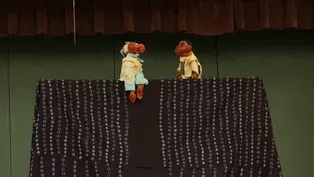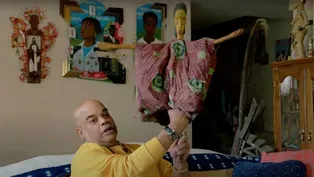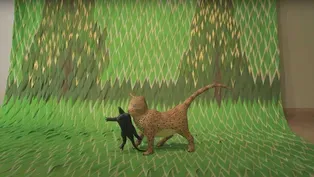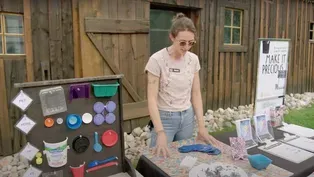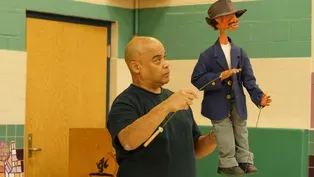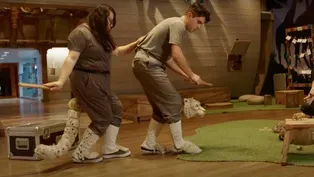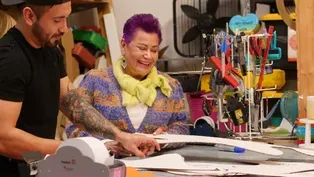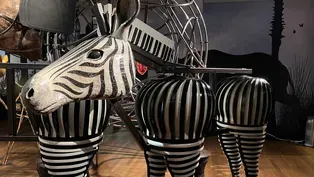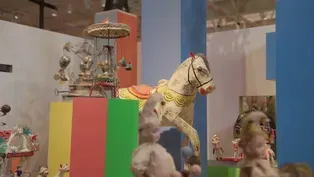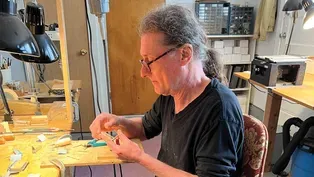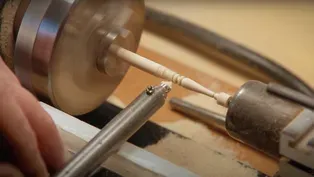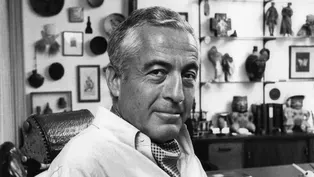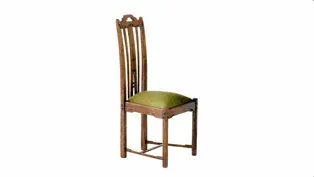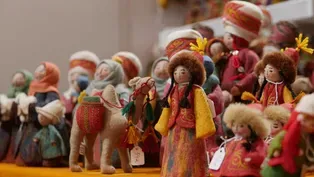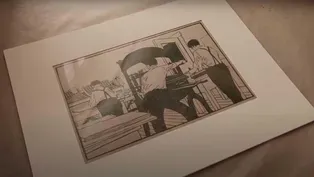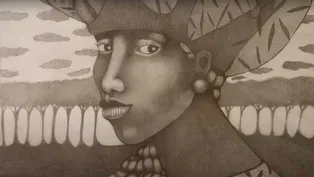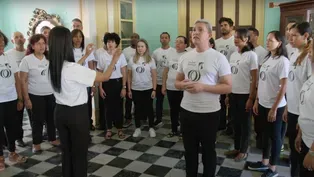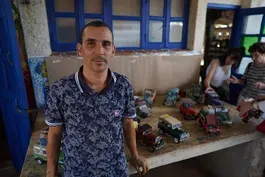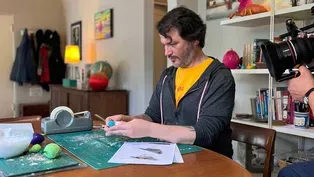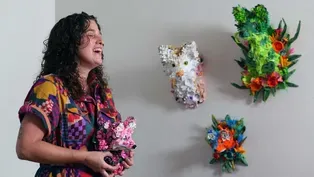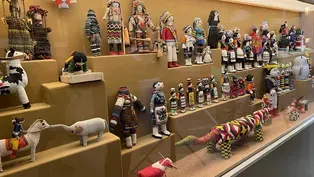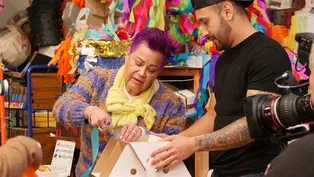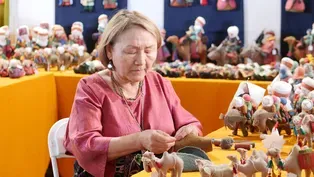
Schroeder Cherry's Civil Rights Childrens Crusade
Clip: Season 15 | 9m 53sVideo has Closed Captions
Schroeder Cherry's puppetry performance, Civil Rights Childrens Crusade
Artist, puppeteer, museum educator Schroeder Cherry's puppetry performance, Civil Rights Childrens Crusade. Bonus video from PLAY, now streaming on PBS App, pbs.org/craftinamerica, and craftinamerica.org. PBS broadcast premiere December 29, 2023 (check local listings).
Problems with Closed Captions? Closed Captioning Feedback
Problems with Closed Captions? Closed Captioning Feedback

Schroeder Cherry's Civil Rights Childrens Crusade
Clip: Season 15 | 9m 53sVideo has Closed Captions
Artist, puppeteer, museum educator Schroeder Cherry's puppetry performance, Civil Rights Childrens Crusade. Bonus video from PLAY, now streaming on PBS App, pbs.org/craftinamerica, and craftinamerica.org. PBS broadcast premiere December 29, 2023 (check local listings).
Problems with Closed Captions? Closed Captioning Feedback
How to Watch Craft in America
Craft in America is available to stream on pbs.org and the free PBS App, available on iPhone, Apple TV, Android TV, Android smartphones, Amazon Fire TV, Amazon Fire Tablet, Roku, Samsung Smart TV, and Vizio.
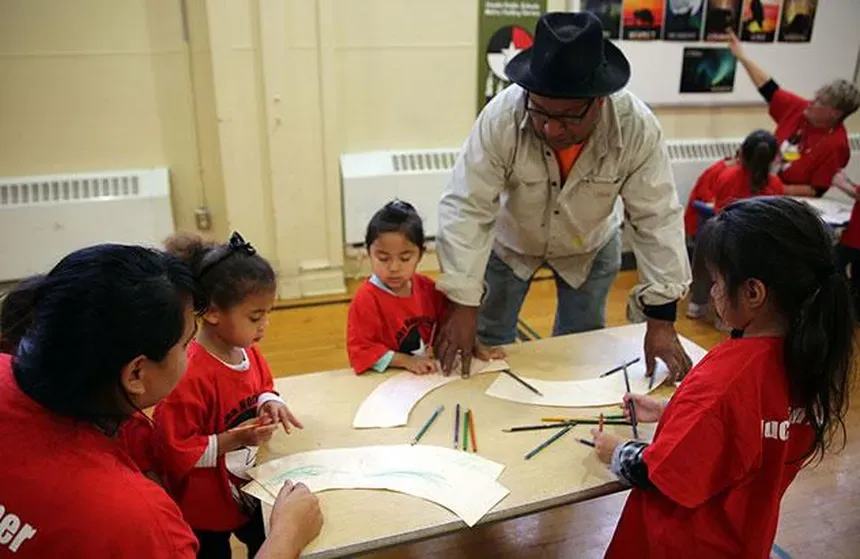
Education Guides
Download Craft in America education guides that educate, involve, and inform students about how craft plays a role in their lives, with connections to American history and culture, philosophies and science, social causes and social action.Providing Support for PBS.org
Learn Moreabout PBS online sponsorshipWow... that's a lot of people here.
Hi, my name is DeAndre and anybody here have a grandfather?
Okay, I have a grandfather and I tell you he is really strict.
He's always on my case.
DeAndre, stand up straight.
Deandre, sit up straight.
DeAndre, pull your pants up.
DeAndre, wear a belt.
DeAndre, watch your language.
Always something.
Makes you wonder what was he like when he was a little kid.
One day we were moving some boxes in the basement and I saw this old timey photograph in a newspaper and the headline said Negro children go to jail and there was this big photograph of all these little kids and they were in jail.
Guess whose face was right there in the middle of that big photograph?
My grandfather.
Yep, couldn't miss him.
Big round eyes, long neck, big ears.
My grandfather still has some big ears today.
They're seriously big ears.
Couldn't miss him.
My grandfather was in jail when he was a little kid.
Holy sh, I mean wow.
Well I had to figure out what that was about.
As it turns out, when my grandfather was a little kid in the South they had a lot of signs and some of them look like this colored and some of them look like this, whites only and they had these signs all over the place they were in restaurants and department stores and bus stations and train stations even on water fountains.
If you saw a store or a train station or even a bathroom that had a sign that said colored, that meant if you were colored or Negro or African-American or Black, then you could use that bathroom or you could drink from that water fountain or you could go into that store but if you went to a store or a restaurant or even a bathroom and you saw a sign like this that said whites only that meant well, you get the idea.
That was called segregation.
They were trying to keep colored people, Black people away from white people.
Can you imagine if they had signs like that today at McDonald's or Wendy's or Target or Walmart?
I can't imagine that, no, no, I can't imagine that.
Well there are a lot of people who didn't like those signs back then either and they were trying to figure out what they could do about segregation.
There was a whole lot of talk about segregation when my grandfather was a little kid and they had a meeting in a church the 16th Street Baptist Church.
That was the largest church in Birmingham, Alabama.
People got together and they were trying to decide what they could do about these segregation signs.
There was one guy he worked with the youth.
His name was James Bevel and James Bevel said people we have to let the children learn how to protest non-violently.
Let the children learn how to protest non-violently and then we can fill up the jails, fill up the jails with children and then somebody will pay attention to our civil rights movement.
Well that was James Bevel's idea but I had to let you know not everybody thought letting their children go to jail was a good idea.
In fact there was a lot of discussion about children going to jail and learning to protest non-violently but the Reverend Shuttlesworth he was a reverend in Birmingham, Alabama and Reverend Shuttlesworth said you got to use what you got so they trained little kids to protest non-violently and I got to say when you learn when you learn to protest non-violently that means you can't fight so if somebody hits you or spits on you or throws something at you, you can't fight back.
You have to be non-violent.
These kids learned to protest non-violently and that's what they were doing so the day before they were supposed to have the protest, there was a DJ and he was on the radio.
His name was Pretty Boy Shelly.
Pretty boy Shelly said children there's going to be a party in the park and everybody knew that was code to meet and protest non-violently so on that day at 12:00 noon, the kids, they left school.
They walked out of, they just walked out of school.
They jumped out of doors They jumped out of windows and they met at the 16th Street Baptist Church.
It was almost like a party.
They were just, they were just meeting.
Now they knew that the police were going to show up and they did.
The police showed up with their batons and they were just ready for a lot of trouble but since the kids had learned how to protest non-violently they knew what to do.
They didn't fight back so the police cars came and they picked up the kids and they took them away and they put them in jails.
Now there were over a thousand kids who showed up on that day.
That was day one.
Now on day two, more kids showed up They came from all over Birmingham, Alabama and they came from other cities too cuz they heard about the protest and protested non-violently.
Now they didn't have Uber back then and a lot of these kids didn't drive so some of these kids came from as far away as 19 miles on foot.
They were walking just so they could protest non-violently and on that day, the police showed up and attack dogs showed up.
I want you to know these attack dogs were really mean.
These attack dogs were trained to bite you and tear your clothes apart and just cause great pain.
Attack dogs.
Also the fire department showed up.
The fire department showed up and they turned on their water hoses.
Those water hosers were powerfully strong.
They were so strong that they blew these kids down the street and this got caught on television cause there were a lot of newspaper people and there were a lot of television cameras going on and people started knowing what was going on in Birmingham, Alabama not only in Birmingham but across the country and even in other countries.
They knew what was going on and when they started to take the children away the cop cars were all filled up.
They had to start using yellow school buses so they took the children away and since the jails were already filled up the yellow school buses took the kids to schools so they started using schools as jails for the kids.
The girls would go to one high school and the boys would sent to another high school.
That was day two.
Now on day three, more kids showed up.
They showed up from all over Birmingham, Alabama and again they came from other cities too.
They just kept coming.
Over a thousand kids were there.
Now this time the jails were all filled up.
The schools were filled up with kids and the television cameras were going on and the newspaper people were there so on that day the police showed up The attack dogs showed up.
The firemen showed up with their water hoses but something changed.
On that day the firemen didn't turn on their water hoses.
They were just tired and I think maybe a little embarrassed with all those television cameras going on so they didn't turn on the water hoses.
The man who was in charge of the police was also the man who was in charge of the fire department, Bill Connor and he was mad.
He was hopping mad.
He said turn those water hoses on.
Blow those kids down the street.
Turn them on right now.
I said it and then he said a bunch of words that I'm not supposed to say because I'm supposed to watch my language but he said turn them on but they didn't turn the water hoses on and that's when things changed.
On that day they made segregation with those signs illegal so you didn't see whites only and you didn't see colors only signs anymore in all those places and that was all because of the Children's Crusade of the Civil Rights Movement and my granddaddy was right up there in the middle, hot dang, I mean, wow.
That's my story about my Granddad.
Thank you.
[Applause]
Woodblock print & marionette maker Gustave Baumann segment
Video has Closed Captions
Multidisciplinary artist, Gustave Baumann, was deeply inspired by Santa Fe (12m 16s)
Underground Railroad, Not a Subway by Schroeder Cherry
Video has Closed Captions
Schroeder Cherry's puppetry performance, Underground Railroad, Not a Subway (25m 34s)
Schroeder Cherry's Civil Rights Childrens Crusade
Video has Closed Captions
Schroeder Cherry's puppetry performance, Civil Rights Childrens Crusade (9m 53s)
Schroeder Cherry's African Puppets
Video has Closed Captions
Artist, puppeteer, museum educator Schroeder Cherry on African puppets in his collection (2m 36s)
Roberto Benavidez on creating piñatas & "piñathkos"
Video has Closed Captions
Artist Roberto Benavidez speaks with curator and art historian on his piñatas & piñathkos (1m 49s)
Recycling plastic through Precious Plastic program
Video has Closed Captions
Sustainability coordinator on recycling plastic through their Precious Plastic program (54s)
Puppeteer Schroeder Cherry segment
Video has Closed Captions
How puppets can become vehicles of history & change: the work of Schroeder Cherry (10m 29s)
Puppeteering the snow leopard at Noah's Ark
Video has Closed Captions
Kinetic designer Chris Green works with Noah's Ark educators on puppeteering snow leopard (1m 47s)
Piñata maker Lorena Robletto segment
Video has Closed Captions
Lorena Robletto creates festive and creative piñatas with fair labor practices at her business, Amaz (6m 14s)
Noah's Ark at the Skirball segment
Video has Closed Captions
Noah's Ark animals made using repurposed materials & Skirball's puppet fest (12m 10s)
Multiple Visions: A Common Bond
Video has Closed Captions
Alexander Girard's folk art collection at Museum of International Folk Art Museum (1m 20s)
Miniaturist Mark Murphy segment
Video has Closed Captions
Woodworker makes tiny furniture: Meet miniaturist Mark Murphy (10m 31s)
Mark Murphy shows us his miniature furniture
Video has Closed Captions
Miniaturist Mark Murphy shows us his miniature 1/12th scale furniture (2m 19s)
Lloyd Cotsen & the Cotsen Children's Library segment
Video has Closed Captions
Lloyd Cotsen founded the Cotsen Children’s Library at Princeton University (5m 45s)
Video has Closed Captions
Lloyd Cotsen's collection of Chinese bronze mirrors, textiles, folk art, Japanese baskets (5m 22s)
International Guild of Miniature Artisans
Video has Closed Captions
Barbara Davis on the International Guild of Miniature Artisans and their Guild School (2m 27s)
International Folk Art Market segment
Video has Closed Captions
Meet artisans at the International Folk Art Market (9m 5s)
International Folk Art Market basket weaver
Video has Closed Captions
Master basket weaver Nelsiwe Dlamini at International Folk Art Market (1m 57s)
Gustave Baumann's Printing the Democrat woodblock print
Video has Closed Captions
Thomas Leech on Gustave Baumann's woodblock print, The Print Shop/Printing the Democrat (1m 10s)
Video has Closed Captions
JELMA curator Schroeder Cherry invites artist Espi Frazier to show her work in the gallery (1m 16s)
El Orfeon Santiago Chorus performance - bonus video from MINIATURES (1m 23s)
Cuban artist Leandro Gómez Quintero segment
Video has Closed Captions
Small scale model cars by Cuban artist Leandro Gómez Quintero (13m 43s)
Calder Kamin on Austin Creative Reuse
Video has Closed Captions
Artist Calder Kamin on how she discovered Austin Creative Reuse (1m 18s)
Artist Roberto Benavidez segment
Video has Closed Captions
Roberto Benavidez's piñatas inspired by medieval manuscripts (8m 24s)
Video has Closed Captions
Calder Kamin creates an art installation by reusing and recycling discarded plastic (10m 6s)
Alexander Girard's miniature folk art collection segment
Video has Closed Captions
Alexander Girard's miniature folk art collection hopes to evoke common humanity. (8m 6s)
Video has Closed Captions
Watch a preview of PLAY, streaming Dec 1, broadcast premiere Dec 29 (1m)
Video has Closed Captions
Watch a preview of MINIATURES, streaming Dec 1, PBS broadcast premiere Dec 29 (1m)
Providing Support for PBS.org
Learn Moreabout PBS online sponsorshipSupport for PBS provided by:

